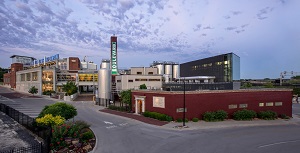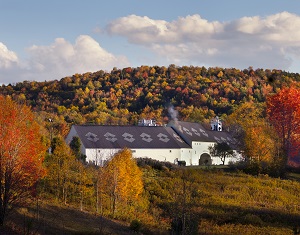Pull Up A Stool with Simon Thorpe
of Duvel Moortgat USA

(Photo by Steve Puppe and courtesy Duvel Moortgat USA)
Firestone Walker Brewing Co.’s Parabola and Union Jack. Boulevard Brewing Co.’s Saison-Brett and Unfiltered Wheat. Brewery Ommegang’s Hennepin and Abbey Ale. And Duvel. As president of Duvel Moortgat USA, Simon Thorpe oversees the work that goes into all of these beers. This requires, he says, keeping two somewhat opposing goals in mind: ensuring each brewery and brand retains individuality while promoting collaboration across the group.
All About Beer: What has caught your attention when looking at the way beer drinkers and beer buyers are approaching the market?
Simon Thorpe: I think there are two or three long-term trends that are really important to everyone. The first is proliferation. There’s a lot of breweries out there; a lot of them are the same or they appear to be the same. I think the most important thing, and we talk about it a lot, is to make sure that we’re developing very distinctive reputations and very distinctive characters for each of the breweries that are sustainable, they resonate. They don’t just resonate in the home market, but they resonate in different parts of the country or abroad. Something that will stand the test of time is the most important thing as we think about proliferation and standing out from the crowd and being around for a very, very long time as opposed to being a flash in the pan.
I think the second is probably the impact that retail has on choices, with all these breweries around. Retail makes a number of important choices, so we’ve focused a lot the last couple of years on our off-premise chain development, really trying to make sure we are doing a really good job with off-premise chain customers. Because that’s where a lot of the decisions on who’s going to survive and who’s going thrive are going to be made.
What are retailers asking for as they make those choices?
The first is that your brand has to stand for something. It has to be distinctive. It has to light a fire within consumers. No. 2 is just our philosophy: We believe in trying to operate at the high end of craft, both in terms of quality but also in terms of the way that people think about beer. It’s valuable. It’s wonderful stuff, and in that sense, we think that making sure that you have a sustainable margin for a retailer is really important. Because if they’re not making money on our beers, then they very quickly lose interest. So we spend a lot of time thinking about how much wholesalers and retail customers are able to make on our beers.
And then I think the third thing is really about rate of sale. There’s an awful lot of beer out there and an awful lot of beer on the shelf. But is it turning? And is it moving and is it growing in the right way? And very simply, we would rather have smaller distribution but really good rate of sale in that distribution than to have distribution everywhere and have rate of sale be turning very slowly. It’s not in the interest of good-quality beer.

(Photo courtesy Boulevard Brewing)
Can you give an example of a beer that’s done that recently?
I’ll give you a couple of examples. Boulevard is the brand of the Midwest, right? I mean, there’s an affection for Boulevard which goes beyond Kansas City. And one of the interesting things there is the acceptance it’s having towards Tank 7. That’s a beer that has caught afire. It’s phenomenal beer, in itself, but the image and what it’s done for Boulevard, the brand, is to really reinvigorate and provide a dynamic nature to Boulevard. To see people in the Midwest embracing Tank 7 in the way that they have has been a big
deal for us.
Ommegang has traditionally been in the high end of craft beer, right at the very top of the pyramid. We introduced Nirvana, which is the first IPA the brewery had ever done, in the Northeast in the last year as a way of making almost a more accessible entry point to Ommegang. And that has done phenomenally well for us.
How does Nirvana or maybe another beer in your portfolio act as an entry point?

(Photo courtesy Brewery Ommegang)
In terms of styles, someone trading from a regular lager may be somewhat intimidated by a cherry, bourbon-aged Belgian quadrupel. IPAs, we know, have been phenomenally successful, partly because they’re an accessible, approachable introduction into flavorful beer, craft beer. There are some IPAs that then are very, very powerful beers. You don’t necessarily start with those, by way of starting to get an introduction to beer. And similarly for a brand like Ommegang, where you have a portfolio of really complex rich beers which the brewery has made its name on, finding a beer which is a little more approachable, a little easier to get into means that you can build a much stronger fan base in your core area in the Northeast. People can drink it more regularly and generally, then they start to look for other things from Ommegang. So it’s a good way of bringing people into the brewery brand.
—This interview was conducted and edited by Christopher Shepard.
Go to the next page to learn more about Simon Thorpe.

Miss u Simon my mans